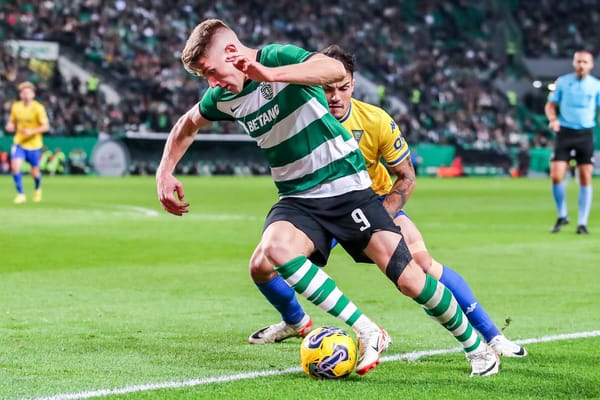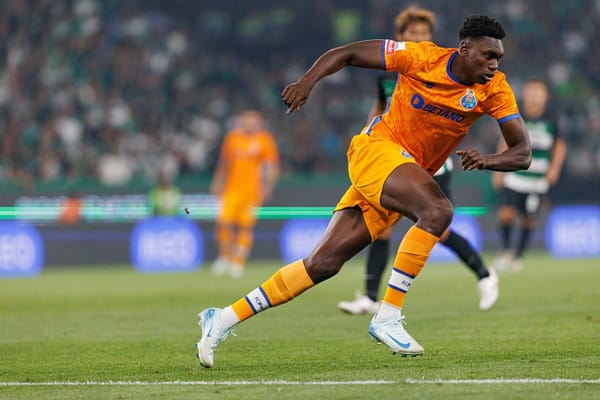Did Barcelona deserve more vs Girona or do the numbers lie?
According to the data, Barcelona maybe even should have won against Girona. But do the numbers lie?

Last Sunday, Barcelona suffered a heavy defeat to now league-leaders Girona. It was a painful match because Xavi's team got outgunned in front of the home crowd in a match that, if won, would've put Blaugrana straight back into the title race. Alas, it was not to be.
However, the narrative of that loss does not match what the numbers suggest; according to the data, Barcelona registered more shots (28 vs 15), more expected goals (4.41 vs 3.04), more positional attacks (37 vs 23) and dominated several other categories as well. They also missed all five of their 'big chances' while Girona only missed two, capitalising on the rest.
So was finishing truly the reason Barcelona lost that game? Let's explore it.
Trial by numbers
Before we start, it's important to note we're using Wyscout's database for all statistics you'll see in this article. The numbers may or may not mirror those from other sources so be mindful of that when comparing your findings. Wyscout states Barcelona took 28 shots in total against Girona, landing 11 of them on target (39.29%).
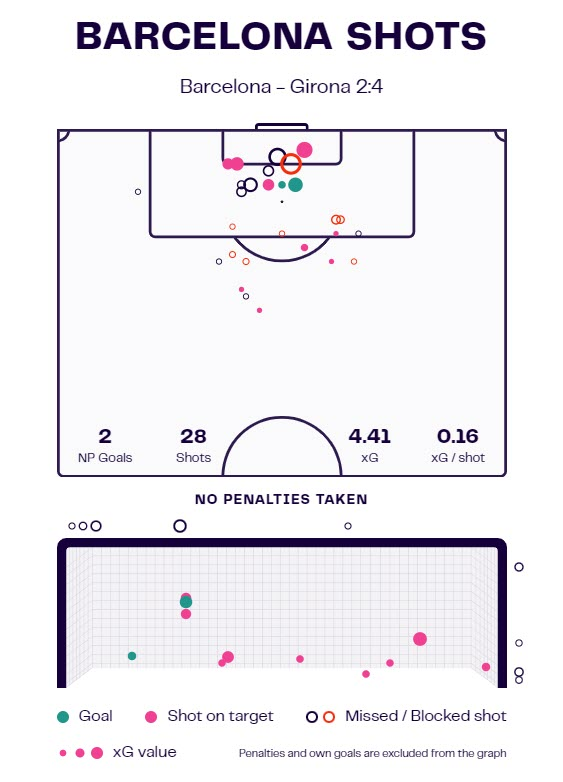
From those 28 shots, they've accumulated a total of 4.41 expected goals, meaning, on paper, they could have and maybe should have scored at least four goals on the night. This also brings their average xG per shot to an outstanding 0.16. In isolation, that seems low but in reality, 0.16 xG per shot in a single game and a sample of 28 shots is incredible.
And indeed, looking at the graph above, we can see the locations of their biggest chances are almost ideal and if you were to look solely at the data, scoring 'only' two goals from that xG and those kinds of chances seems wasteful. Let's look at it from Girona's perspective next.
The following two graphs show us all the shots Girona's defenders managed to block and all the shots Paulo Gazzaniga faced against Barcelona throughout the night.
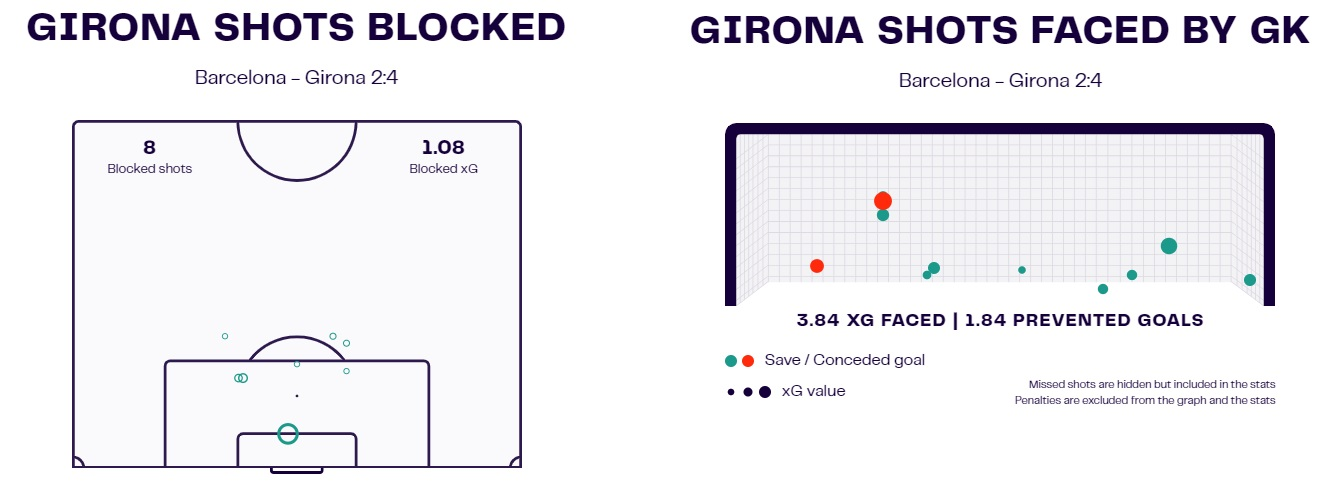
When we combine the data from both, we can see Girona prevented 2.92 expected goals by sheer defending, either through their goalkeeper or the defenders ahead of him. We also see that many of these Barcelona attempts were lower xG attempts which add up and create an illusion of a much higher xG total. That being said, the data would suggest there were at least a couple of big chances Barcelona either wasted or Girona saved.
So far, the Barcelona side does look quite impressive; the sheer stats suggest a dominant display in attack. The numbers paint an optimistic picture of an attacking juggernaut if we assume this production continues. In fact, a team that regularly creates that much is bound to eventually start cashing in once the actual goalscoring catches up with the expected goalscoring.
But let's switch our focus to Girona's attack now.
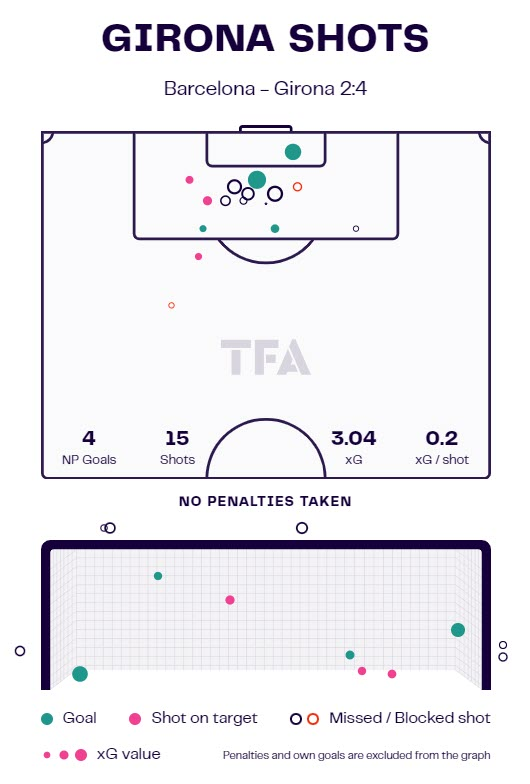
Immediately, we see Girona have recorded weaker numbers in two out of the four categories we see on the graph: total shots (15) and xG (3.04). However, they've managed to score four goals and have registered an incredible 0.2 xG per shot on average. This means their chances of scoring were that much higher on a sample of 15 shots even though their total xG on the night was lower.
In other words, they had fewer chances but those chances were, on average, easier to convert. As contradicting as it may sound at first, Girona had less overall xG but had better chances to score more goals. Convoluted still? It will make more sense once we get to the eye test part.
Moving on, we'll now look at those shots from Barcelona's defensive perspective, once again focusing on shots blocked and goals prevented by the goalie.
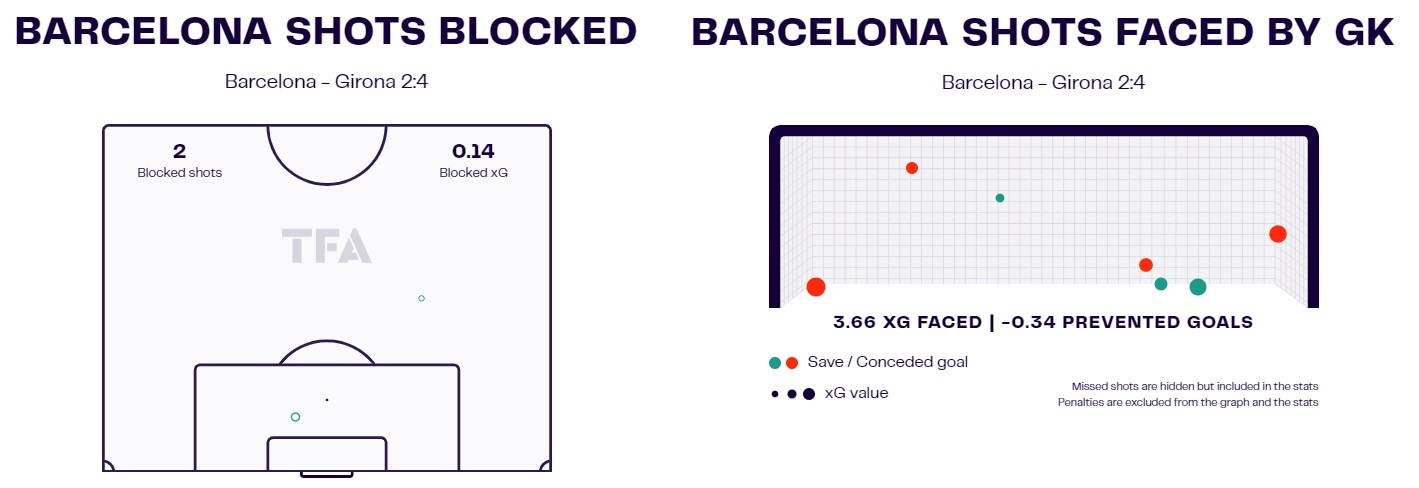
The situation is slowly beginning to unravel. Barcelona have only managed to block two shots, nullifying as little as 0.14 xG. On the other hand, Inaki Pena faced 3.66 xG, preventing -0.34, meaning that when we combine the blocks and preventions, they still have a net negative of -0.20 prevented/blocked attempts overall. When compared to Girona's 2.92 (blocks + goalie preventions), the difference is glaring and damning. But Barcelona also faced a total of 3.66 xG while Girona faced only a bit more, 3.84. The difference is almost irrelevant and then completely nullified once we add the defending into the equation.
In fact, if we balance those two out we get that Barcelona conceded a total of 3.86 (3.66 + 0.20) and Girona conceded a total of 0.92 (3.84 - 2.92). Note that in Barcelona's case, we added the 0.20 because Barcelona had a net negative prevented goals while in Girona's case, we subtracted because they had a net positive prevented goals.
So the sheer numbers tell one story but when we dig deeper, we find there's more than meets the eye. But does the eye test confirm this thesis?
The Eye Test
In this section of our analysis, we'll take a look at Barcelona's and Girona's statistically best chances, ie chances that resulted in the highest xG value. When we compare the two, we'll hopefully be able to deduce whether our thesis from the trial by numbers was valid - were Girona's chances 'easier' to convert even though the total expected goals value was on Barcelona's side? Let's find out.
We'll start with Barcelona's highest xG attempt which belongs to Robert Lewandowski's chance in the seventh minute of the game, carrying a huge 0.64 xG.
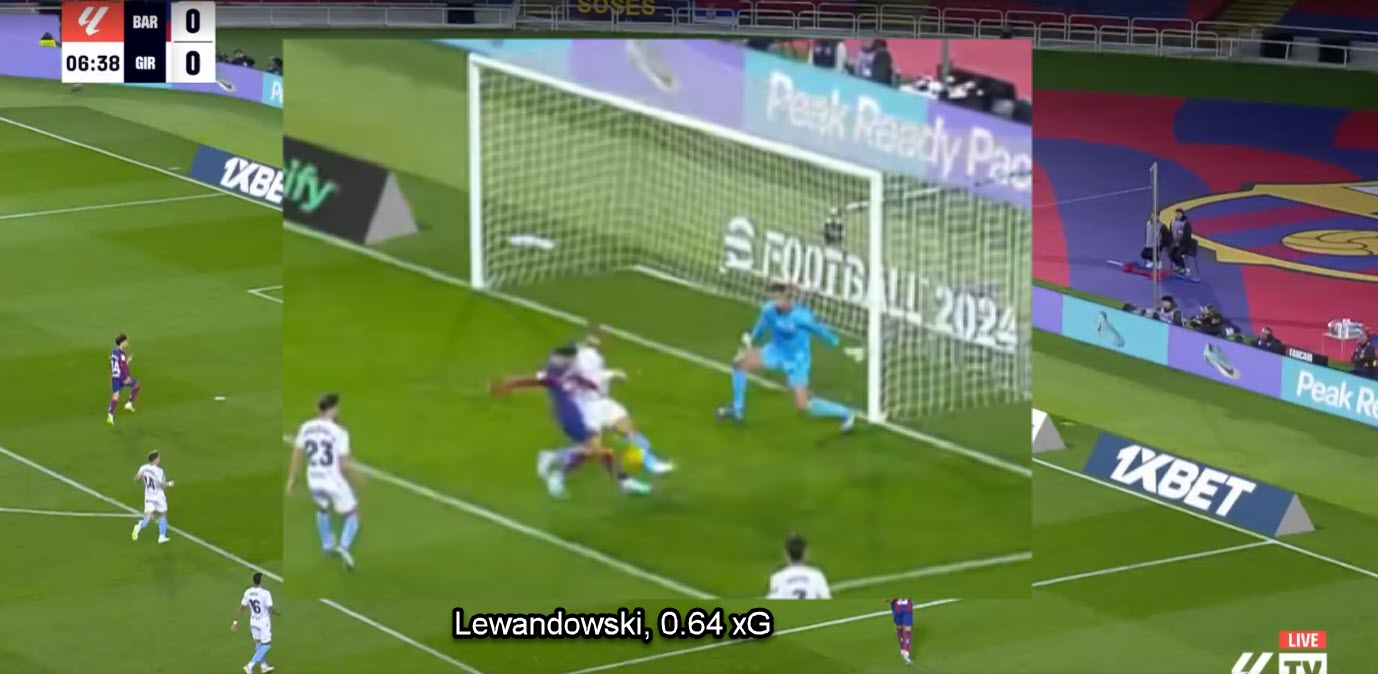
According to the expected goal system, Lewandowski should score this goal 64% of the time. That's a ridiculously high value and shows the flaw of the whole system. On paper, if you look at it from a data point of view, it makes sense; Lewandowsky is close to the goal, has only one defender in front of him and has managed to make contact with the ball as well.
In reality, however, this is nowhere near a 0.64 xG situation. There are several reasons for that. First of all, if you go a couple of frames back in this sequence, you see that at the moment Pedri releases the pass to Lewandowski, the Pole is caught flat-footed for just enough that the defender gets a fraction of a second of a headstart, beating him to the ball ever so slightly. That means he's already on top of Lewandowski to block the shot once the Pole connects with the pass. The second thing is the positioning of the goalkeeper, who is directly in the ball's trajectory should it ever get past the defender in the first place. But there is an incredibly tight angle for Lewandowski to squeeze the ball through. Finally, look at Lewandowski's body shape and the opposition's momentum to attempt the block; all of it dwindles this opportunity. According to data, this is a big chance, the biggest in the game even, but realistically, it's a very difficult one to execute, let alone convert 64% of the time.
The second example comes courtesy of Raphinha in the 18th minute, carrying an xG of 0.48, meaning the player has a 48% chance of scoring the attempt.
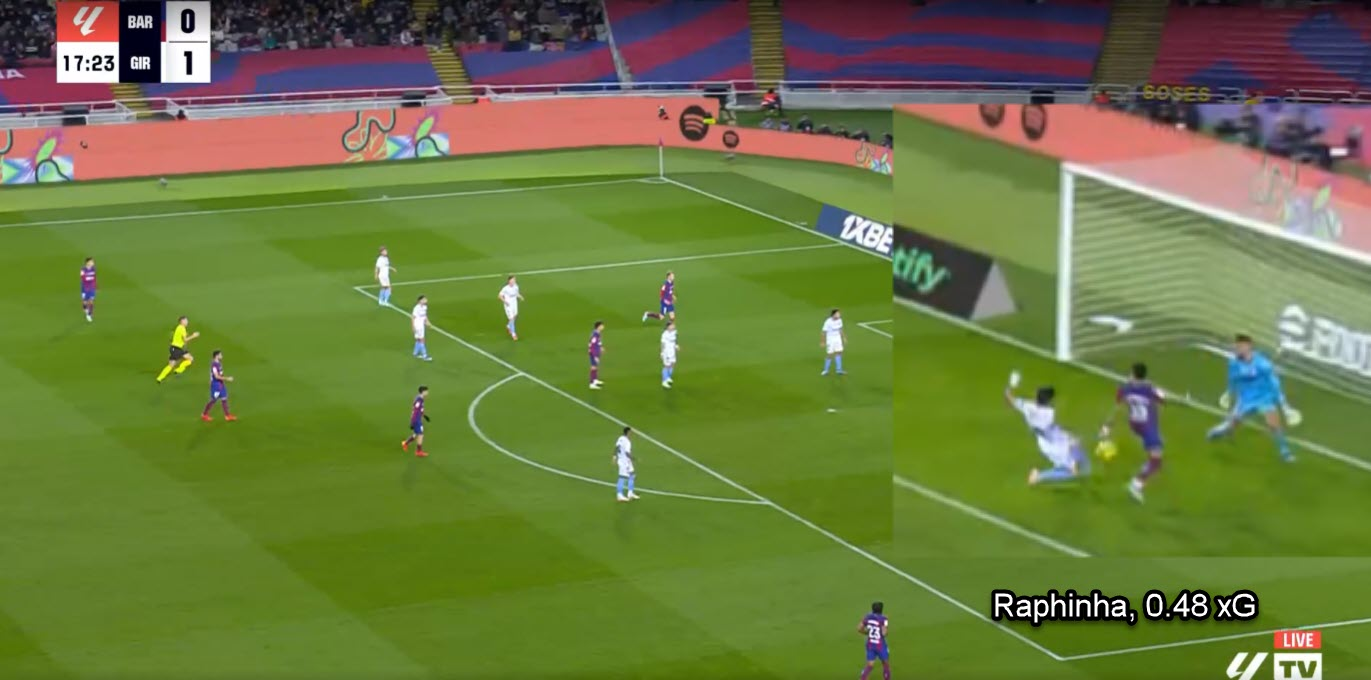
Again, on paper, this is as clear-cut as they come. And truthfully, it is theoretically an easier chance to convert than the one analysed earlier. All Raphinha has to do is time his run better and make proper contact with the ball. However, he doesn't. It's quite difficult to discern from the camera angles available to us but it doesn't even seem like Raphinha touched the ball at all.
If he did, it was a faint touch at best which was not enough to beat Gazzaniga. In the right circumstances, this would be a huge opportunity but again the defender is there in time to make this more of a prevented goal from Girona, disrupting the flight of the ball and Raphinha's reception, than a wasted one from Barcelona.
Next in line is Lewandowski's 0.34 xG chance from the 48th minute of the first half.
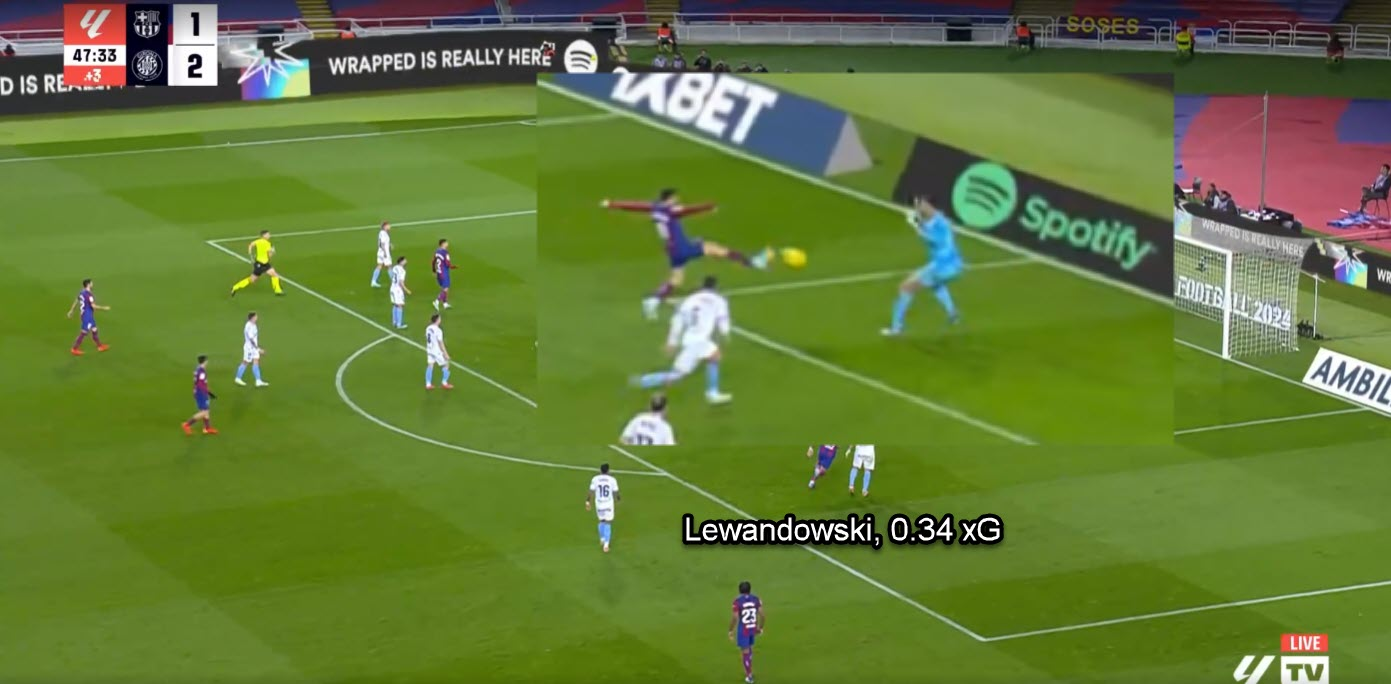
This situation is quite similar to Raphinha's because in ideal circumstances (better timing/more speed, firmer contact), Lewandowski would be cleanly positioned to take the shot. However, as we can see from the image above, he barely touches the ball in the first place and all he can muster is a faint shot at best. Note that this isn't Lewandowski in a jumping finish but rather him stretching out as much as he possibly could at that moment.
Once again, from a data point of view, a player alone in that position taking a shot at goal would normally result in a very high xG chance. However, what the data doesn't tell us is that Lewandowski could barely get a sniff at the ball despite being unmarked and attempting a shot, which, without context, is an almost ideal situation to score.
Finally, we have Ilkay Gundogan's chance from the 86th minute, carrying a value of 0.46 xG, which rounds off Barcelona's four biggest chances of the night according to the statistics.
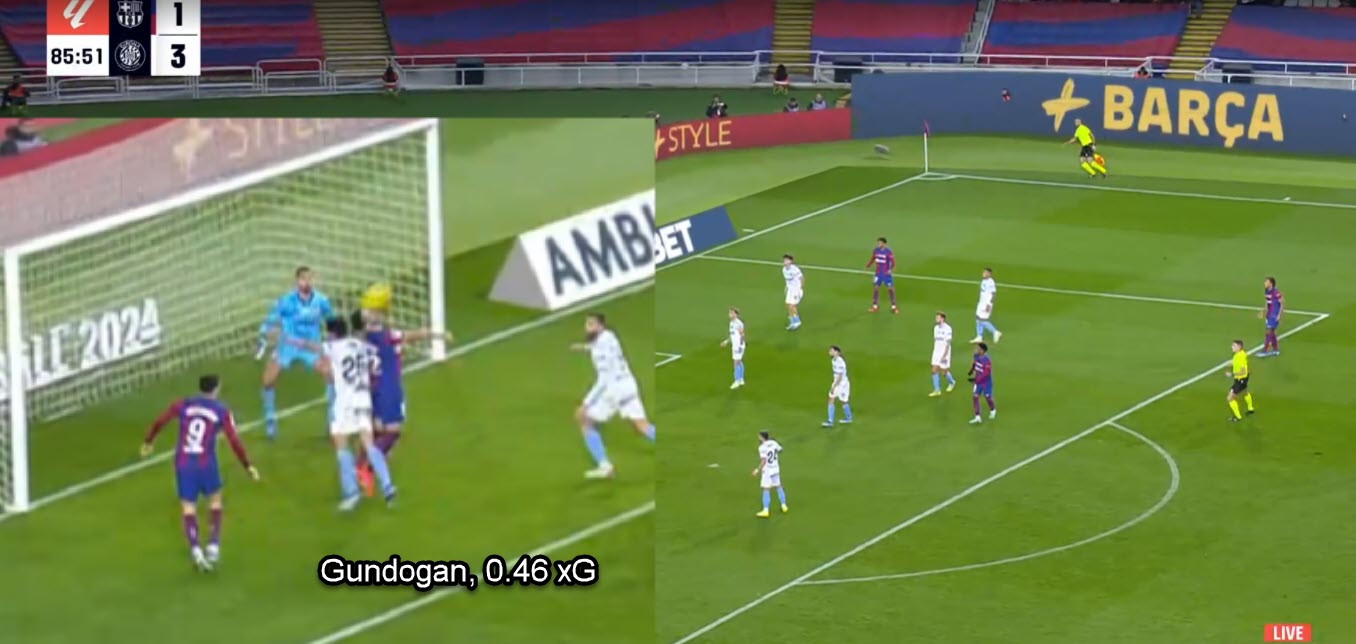
This might be the most difficult of the four chances to finish and yet, the data suggests Gundogan should convert 46% of the time. To his credit, the German manages to flick the ball over his head despite it hitting him almost straight in the face but the attempt was nowhere near rattling the inside of the net. His body position, the trajectory of the ball and the defender on his back make this an almost impossible chance but one that would be classified as 'big' according to the stats.
These four attempts make out 1.92 out of 4.41 xG for Barcelona and yet, none of these chances were nearly as clear-cut as they are presented to be. So I went through the rest of Barcelona's 24 shots to see how big were the remaining 2.49 xG attempts and concluded only three of those 24 could have been goals. The rest? Mostly (blocked) long shots that would require luck or near-perfect execution and ball-striking from distance to be converted. In other words, the rest were largely unreliable.
The following three I deemed 'more likely' or 'more realistic'.
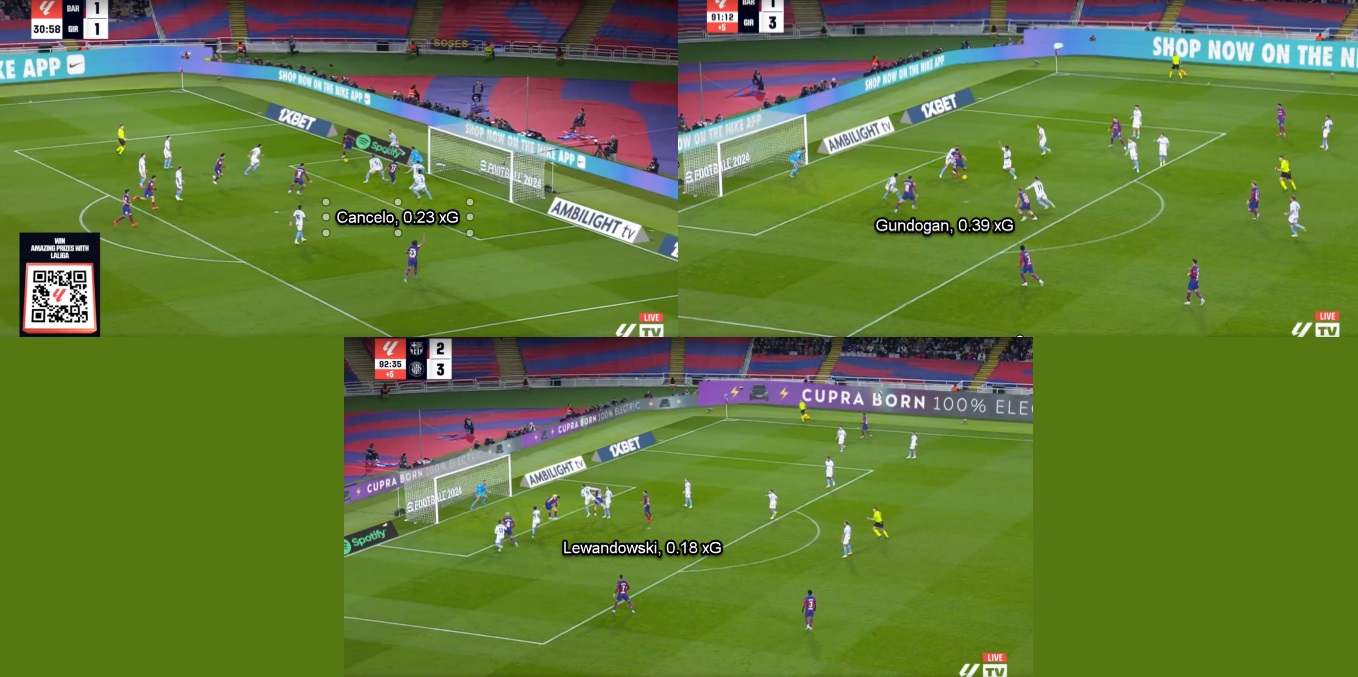
The first one is the controversial Joao Cancelo shot that arguably should've been a pass. Had he passed the ball to Lewandowski, this could've been a dangerous situation for Girona. Alas, with him trying to squeeze the ball past several defenders and a goalie was... Difficult. The Gundogan chance is the only attempt of the three which actually resulted in a goal. It's not an easy chance by any means but it was a stellar finish nonetheless. Finally, the most clear-cut chance of the night goes to Lewandowski's header in the dying minutes of the game.
According to Wyscout's xG model, this is only a 0.18 xG chance. Is it an easy attempt? I doubt it. But a striker of Lewandowski's calibre should be converting this more often than not or at least put it on target. In my opinion, this should be higher than 0.18 and it should've been a goal. But that's probably the only clear-cut chance out of the whole lot.
Let's focus our attention on Girona's chances next. They accumulated 3.04 xG on the night but we argued they had 'easier' chances to convert despite the lower expected goals value across the board.
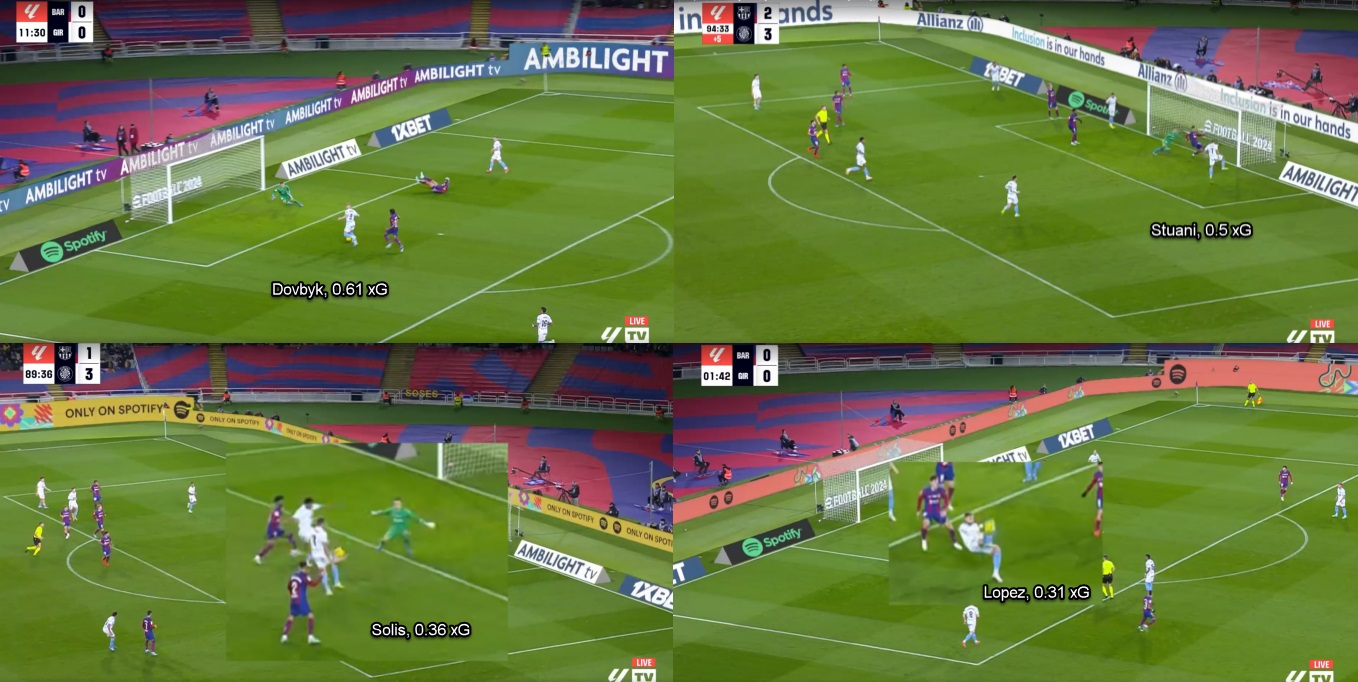
These are Girona's four statistically best chances of the night. All four are very high in xG and only one of those four, namely the last one, is an extremely difficult attempt to convert. The rest are far more straightforward. The first two, in particular, are essentially tap-ins while the third one is more difficult because of the motion and proximity of defenders around the player attempting the shot. But even still, it's a clear attempt that was wasted rather than the defending team preventing it.
When it comes to the other realistic chances with comparatively lower xG values, I found that out of the remaining 11 attempts, six were promising, two of which were converted as well.
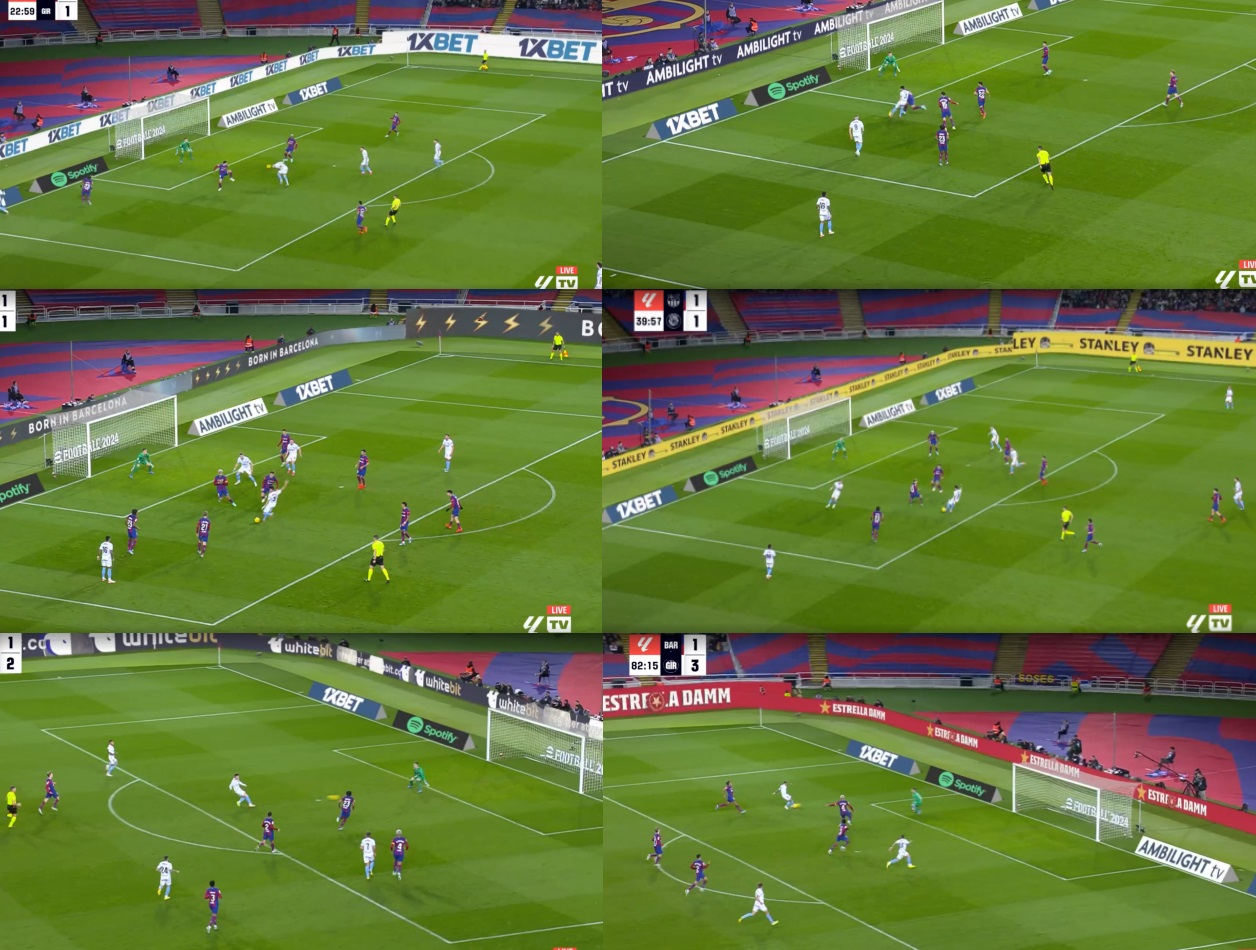
To conclude, out of their four statistically biggest chances, they scored two but realistically should've had three. Out of Barcelona's four statistically biggest chances, they scored zero and realistically should've had zero. Along the same lines, out of the remaining 24 attempts, Barcelona had three realistic ones at best, one of which was scored and one more arguably should've been scored. Out of Girona's remaining 11, six were realistic chances, two of which were scored but two others were promising at the very least.
Final remarks
Data painted a picture of Barcelona who created a lot but couldn't convert at all. However, upon further analysis, we conclude most of their chances should've been either much lower in xG value or not classified as big in the first place. Girona, on the other hand, created far more 'easier' chances despite their overall lower xG value on the night.
Barcelona maybe should've had more but this isn't a game they dominated and would've won with better finishing, as painful as it is to admit.
The better team won.


